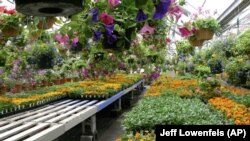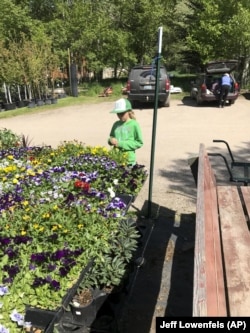Many gardeners do not begin to grow their plants from seeds.
Instead, they buy young plants, also called seedling or “starts.” These are plants that are grown in a nursery: a place where plants are grown and sold.
Many gardeners buy seedlings in containers for their gardens.
Most nursery seedlings are either plants that last for one growing season or are vegetables. They come in plastic containers holding four to six plants. Many people also buy “starts” in individual containers.
But it is important to pay attention when buying spring starts. A gardener usually cannot go back and begin again in the middle of spring or summer. And a good gardener wants to have plants that perform for the season.
Here is some helpful information to help get good plants:
The first step is finding a good nursery. A good gardener will ask themselves if it looks like the nursery grows its own plants, or buys them from larger growers. Nurseries that grow their own spring starts usually take good care of them. The larger growers, or wholesalers, might not be able to do so.
Make sure the plants have been watered correctly. If not, the seedlings will have a hard time developing. If there are lots of half-dead or dried-out plants, it is often a sign to buy elsewhere.
Next, before buying a grouping of seedlings, feel the soil. In addition to being wet but not flooded, it should not be dense. That is a sign of it having been dried out. In fact, the soil should smell fresh.
Look at the holes at the bottom of the container to see the roots. If the roots are too dense, that is a sign not to buy the plant. Look to see if there has been damage from the wind or sun. Damaged plants will take time to repair.
Also look for signs of fungal or bacterial infection. Plants should be free from insects and not have the smell of chemicals.
When buying spring plants in cell containers, all the plants in the group should be healthy. If one out of four plants in a grouping is not healthy, the others might not be far behind.
A gardener should also know what plants they are buying. Look for the name of the kind of plant, the color and the height. That information can help gardeners buy the same plants in the future if they perform well.
Many people ask about buying plants that are already flowering. Some plants will flower all season long, so that will not be a problem. However, other plants will flower once and never again. Avoid plants that have already flowered early in the season.
Finally, always have a plan when buying plants. Something that helps gardeners is a simple drawing of their garden and a list of the plants they will buy. Some people even have it on their phone so it is always with them when they are at a nursery.
I’m Gregory Stachel.
Jeff Lowenfels reported this story for The Associated Press. Gregory Stachel adapted it for VOA Learning English.
__________________________________________________________________
Words in This Story
garden – n. an area of ground where plants (such as flowers or vegetables) are grown
soil – n. the top layer of earth in which plants grow
fungal –adj. having to do with fungus: a kind of plant-like living things that do not have flowers or seeds
drawing – n. a picture or image that is made by making lines on a surface with a pencil, pen, marker, chalk, but usually not with paint
We want to hear from you. Write to us in the Comments section, and visit our Facebook page.









